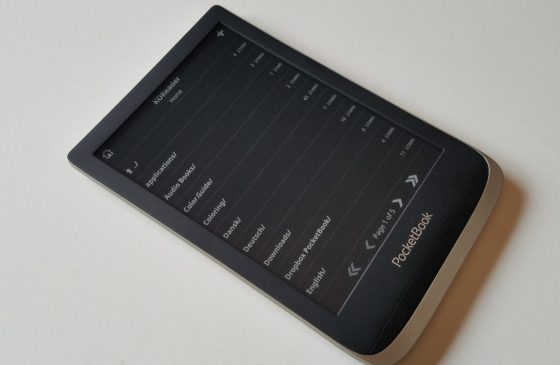One of the nice things about Pocketbook’s ebook readers is they are open to install alternative reading apps.
Pocketbooks run a Linux-based operating system so they can’t install Android apps, but they can install a few apps that works alongside the built-in reading software, including KOReader.
KOReader is a popular reading app that’s available for Android and several dedicated reading devices, such as Kobos and jailbroken Kindles.
I installed KOReader on the Pocketbook Color to try it out, and while it does work to some extent, it’s definitely buggier on the Pocketbook than it was the last time I installed it on a Kobo. Sometimes it freezes up and won’t respond, and color content is not displaying properly, even though it says color is enabled in the settings menu, but I haven’t had much time to mess with it yet.
However, one thing I do like with KOReader is the ability to use inverted mode for white text on a black background, something the default software lacks. It helps hide the color filter layer that’s visible on E Ink’s new color screens.
If you want to try KOReader on a Pocketbook ereader, there’s a set of installation directions over at GitHub. Here’s what I did:
1. Plug the Pocketbook ereader into a computer with the USB cable and select PC Link mode on the Pocketbook.
2. Download a Pocketbook version of KOReader from their latest releases page. Make sure to download a version labeled koreader-pocketbook.
3. Extract the downloaded file on your computer and then transfer the koreader folder and koreader.app files located within the applications folder to the applications folder on your Pocketbook. Apparently it isn’t necessary to transfer the system folder, as the directions at GitHub don’t mention it.
4. Safely eject the Pocketbook from your computer and restart the device (I don’t know if it matters but it seems like a good idea).
Now you can access KOReader from the app section on the Pocketbook. If you haven’t used KOReader before there’s a learning curve, but you can find a number of tutorials at GitHub. Here’s their getting started guide and a tips and tricks guide.


Interesting,
I may be interested enough to pull the trigger on an Inkpad X if Kobo or Kindle don’t come out with a new large reader this fall.
You might as well do it then. I can’t see Kindle or Logo going that route ever, let along this year in particular.
I use KOReader on my Pocketbook Inkpad 3 and it’s mostly fine, but it does occasionally freeze the entire reader and require it to be hard rebooted with the power button. I have yet to discern a pattern to this behavior. Some builds of KOReader seem more stable than others so once I get one that freezes less often I tend to stick with it until there’s a new release where the release notes look like it has something I might want or that might help with stability (like “fix memory leak” or whatever).
Other KOReader glitches I encounter regularly:
― It’s exceedingly slow to reformat if I change margins or fonts or rotate the screen or whatever.
― Some operations (especially in the file manager, but not exclusively there) will seem to be stuck or non-responsive until I do something to nudge it, like tapping the screen.
― The first time I start it after powering up, the dictionary lookups don’t work. I tend to forget about this until I try to do a dictionary lookup and it just sits there until I cancel it. This happens every single time I restart the device.
Despite these inconveniences, I keep using KOReader, because it’s just that much better than the stock e-reading app on the device. Not that there’s really anything wrong with the stock app―I mean, it works, if all you want to do is read―but I like the statistics, better dictionary options, footnote handling, margin adjustments, etc., that are available in KOReader. (Have I filed bug reports for any of this? Of course not. I just put up with it.)
These problems were solved from the recent version nightly 2020.08.1-44. KOReader now works correctly on most PocketBook devices.
Oh nice! I will have to update and try it out!
What dictionaries can you use on Koreader??
Oh it uses the StarDict format and you can install as many as you want, although I think they recommend not having too many just to make searches faster. I have three dictionaries running on mine. You can get StarDict dictionaries from various sites, such as http://download.huzheng.org/bigdict/.
Basically you just unzip them and put them in the dict folder in the KOReader folder tree of your device. Instructions and other links are at https://github.com/koreader/koreader/wiki/Dictionary-support.